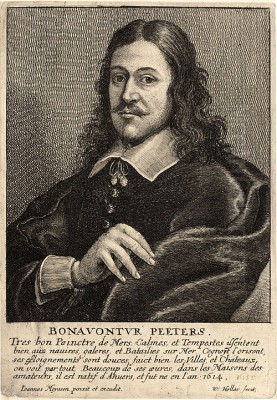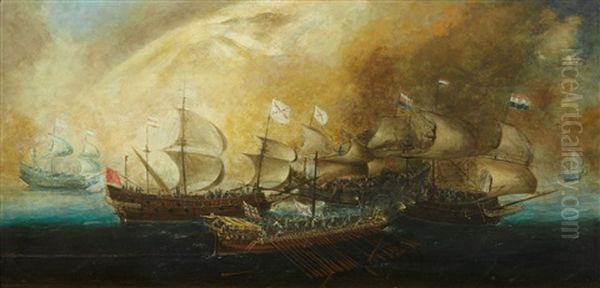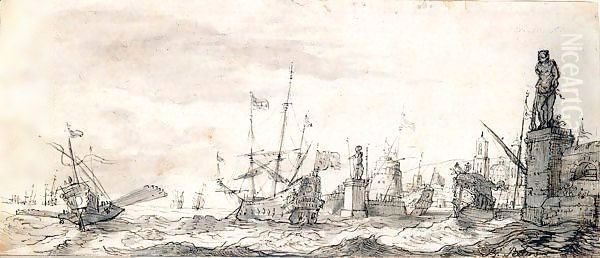
Bonaventura Peeters the Elder stands as one of the most significant and prolific marine painters of the Flemish Baroque era. Active during the vibrant artistic period of the 17th century, Peeters carved a distinct niche for himself, specializing in dramatic and evocative depictions of the sea, ships, and coastal landscapes. Born into an artistic dynasty in the bustling port city of Antwerp, his life and work were intrinsically linked to the maritime world, which he portrayed with remarkable skill, versatility, and emotional depth. From tempestuous shipwrecks to tranquil harbour scenes, and from familiar Flemish shores to exotic, faraway coastlines, Peeters captured the power, beauty, and peril of the sea, leaving behind a rich legacy that continues to fascinate art lovers and historians alike.
Antwerp Origins and Artistic Formation
Bonaventura Peeters was born in Antwerp in 1614, a city that was not only a major European economic hub but also a crucible of artistic innovation, still basking in the glow of Peter Paul Rubens's towering influence. He was part of a family deeply embedded in the city's artistic fabric. His brothers, Gillis Peeters (1612–1653) and Jan Peeters I (1624–1677), were also painters, as was his sister, Catharina Peeters (1615–1676). This familial context undoubtedly played a crucial role in his early training and artistic development, fostering an environment where artistic skills were cultivated and shared.
While the specifics of his earliest training remain undocumented, it is highly probable that he learned the fundamentals of painting within the family circle. In 1634, at the age of twenty, Bonaventura was officially registered as a master in the prestigious Antwerp Guild of Saint Luke, the city's primary institution for artists and craftsmen. This membership marked his formal entry into the professional art world, granting him the right to establish his own workshop, take on pupils, and sell his works independently.

Early stylistic influences point towards Andries van Eertvelt (1590–1652), an older Antwerp master who was a pioneer of marine painting in the Southern Netherlands. Van Eertvelt's works often retained elements of the late Mannerist style, characterized by somewhat artificial colouring and dramatic, albeit sometimes stylized, compositions. While Peeters may have initially absorbed aspects of Van Eertvelt's approach, his artistic trajectory soon veered towards a more naturalistic and tonally refined style.
The Influence of Dutch Marine Painting
A defining characteristic of Bonaventura Peeters's mature style is his engagement with the innovations occurring in marine painting in the neighbouring Dutch Republic. The Dutch Golden Age saw an explosion in marine art, driven by the nation's maritime power and commercial success. Peeters appears to have been particularly receptive to the tonal phase of Dutch landscape and marine painting that emerged in the 1620s and 1630s.
Artists like Jan Porcellis (c. 1584–1632) revolutionized the genre by moving away from colourful, detailed depictions towards more atmospheric scenes emphasizing subtle gradations of grey and brown tones to convey weather conditions and the vastness of the sea and sky. Simon de Vlieger (c. 1601–1653), another leading Dutch marine painter, was known for his realistic portrayal of ships, water, and light, often capturing calmer seas with remarkable sensitivity. The influence of Dutch landscape painters like Jan van Goyen (1596–1656) and Salomon van Ruysdael (c. 1600/03–1670), masters of tonalism and atmospheric perspective, can also be discerned in Peeters's handling of light, colour, and mood.
Peeters adeptly synthesized these Dutch influences with his Flemish heritage. He adopted the more naturalistic palette and atmospheric concerns of the Dutch tonalists but often retained a Flemish penchant for drama, detail, and sometimes stronger local colour than his Dutch counterparts. This fusion resulted in a distinctive style capable of rendering both the fury of a storm and the quietude of a harbour with convincing realism and emotional resonance.
The Peeters Family Workshop
Artistic collaboration within families was common practice in 17th-century Antwerp, and the Peeters family was no exception. Bonaventura is known to have shared a studio with his older brother Gillis upon becoming a master in the Guild. This close working relationship facilitated the exchange of ideas and techniques and likely contributed to the high productivity associated with the Peeters name. Their younger brother, Jan Peeters I, and sister, Catharina, also became accomplished painters, often working in styles closely related to Bonaventura's, particularly in marine subjects.

This familial collaboration occasionally makes definitive attribution challenging, especially for unsigned works. Catharina Peeters, for instance, developed a style so similar to Bonaventura's that some works previously attributed to him are now considered potentially hers. However, Bonaventura generally stands out as the most innovative and influential marine painter within the family.
A significant example of their collaborative efforts is The Siege of Kallo (also spelled Callo), painted in 1639. This large-scale work, depicting a recent military engagement during the Eighty Years' War, was commissioned by the Antwerp city authorities. It showcases the Peeters workshop's ability to handle complex historical subjects and likely involved contributions from both Bonaventura and Gillis, blending landscape, marine, and figurative elements into a dynamic composition. Such commissions underscore the family's standing within the Antwerp art scene.
Master of Maritime Drama: Style and Subject Matter
Bonaventura Peeters the Elder is perhaps best known for his dramatic depictions of ships battling fierce storms or foundering on rocky coastlines. These works capture the terrifying power of nature and the vulnerability of human endeavours at sea. He excelled at rendering tumultuous waves, dark storm clouds pierced by lightning, and ships tossed precariously, their sails torn and masts broken. These scenes often carry a sense of immediacy and high drama, appealing to a contemporary fascination with the dangers and adventures of maritime life. The Haven of Refuge (1635, Queensland Art Gallery), an early example, already shows his ability to convey peril and hope amidst a storm.
However, Peeters's repertoire was far broader than just shipwrecks and storms. He painted a wide variety of marine subjects, demonstrating considerable versatility. Calm seas, bustling harbours, tranquil river estuaries, and naval battles were all part of his oeuvre. He depicted specific types of vessels with meticulous attention to detail, reflecting his keen observation and understanding of contemporary shipbuilding and rigging. Dutch fluyts, merchant galleons, warships, and smaller fishing boats populate his canvases, rendered with an accuracy that appeals to maritime historians as well as art lovers.
His settings ranged from local Flemish and Dutch waters, such as the River Scheldt near Antwerp, to the coasts of Scandinavia. Shipping on the Scheldt off Antwerp, for example, showcases his ability to create a realistic illusionistic style through fine brushwork and clear, harmonious tones, capturing the specific light and atmosphere of his home region.
Depicting the Exotic and Faraway
A particularly intriguing aspect of Peeters's work is his depiction of exotic and distant locations, places he likely never visited himself. His paintings feature identifiable or imaginary views of Mediterranean ports, often characterized by classical ruins, bustling quaysides, and distinctly southern light. He also painted scenes set along the coasts of South America and even the icy waters of the Arctic, most notably in his Port of Archangelsk (1644, National Maritime Museum, Greenwich).
This interest in the exotic reflects a broader European fascination with global exploration, trade, and the expansion of geographical knowledge during the 17th century. Antwerp, as a major international port, would have been a hub for sailors, merchants, maps, and travel accounts, providing Peeters with ample source material. He likely drew inspiration from prints, maps, illustrated travelogues, and perhaps even the work of artists who had travelled, such as Frans Post (1612–1680), known for his Brazilian landscapes.
Peeters's depictions of these faraway places often blend topographical accuracy with imaginative elements, creating compelling visions of distant shores. Works like Südliche Hafenstadt mit dem Anlanden von Zwei Schiffen (Southern Port City with Two Ships Landing, 1644) exemplify this, combining detailed observation of shipping with a somewhat idealized, picturesque vision of a Mediterranean harbour. These paintings catered to a market eager for glimpses of the wider world.
Analysis of Key Works
Several paintings stand out as representative of Bonaventura Peeters's skill and thematic range:
The Siege of Kallo (1639, Royal Museums of Fine Arts of Belgium, Brussels, with Gillis Peeters): As mentioned, this collaborative work demonstrates the workshop's capacity for large-scale historical painting. It combines a detailed rendering of the landscape and fortifications with lively depictions of military action and shipping on the Scheldt, showcasing a blend of topographical accuracy and narrative dynamism.
Shipping in Choppy Seas off Willemstad (c. 1641-1652, formerly Goldschmidt Collection): This painting is a prime example of Peeters's ability to capture the movement and energy of the sea. The waves are rendered with vigour, and the ships heel realistically under the force of the wind. The interplay of light and shadow across the water and clouds creates a convincing sense of atmosphere and weather. The detailed depiction of the Dutch flags and the specific location add topographical interest.
Port of Archangelsk (1644, National Maritime Museum, Greenwich): This work is significant for its depiction of a remote but important trading post in northern Russia. Peeters captures the unique architecture and the mix of Western European and Russian vessels in the harbour. While likely based on secondary sources, the painting conveys a sense of place and highlights the global reach of maritime trade networks. The cool light and meticulous detail contribute to its documentary feel.
Shipping on the Scheldt off Antwerp (various versions): Peeters returned frequently to scenes set on the river near his home city. These works often display a calmer mood than his storm scenes, focusing on the daily traffic of merchant vessels and fishing boats. They showcase his skill in rendering calm water, reflections, and the specific atmospheric conditions of the Low Countries, often employing the subtle tonal harmonies learned from Dutch painters.
A Naval Battle (Private Collection): Peeters also depicted the more violent aspects of maritime life, including naval engagements. These paintings allowed him to combine his skill in rendering ships and water with the drama of cannon fire, smoke, and damaged vessels, reflecting the frequent conflicts that characterized the era.
Wider Artistic Context and Contemporaries
Bonaventura Peeters the Elder operated within the rich artistic landscape of the Flemish Baroque, dominated by figures like Peter Paul Rubens (1577–1640), Anthony van Dyck (1599–1641), and Jacob Jordaens (1593–1678). While Peeters specialized in a different genre, the overall artistic climate of Antwerp, emphasizing technical skill, dynamic composition, and often dramatic expression, undoubtedly formed part of his background.
Within the specific field of marine painting, Peeters was a leading figure in the Southern Netherlands during the mid-17th century. While marine painting flourished more extensively in the Dutch Republic, Flanders had its own practitioners. Besides Andries van Eertvelt, other Flemish artists who occasionally painted seascapes included Gaspar van Eyck (1613–1674) and later Hendrick van Minderhout (1632–1696). However, Peeters stands out for his specialization, prolific output, and successful integration of Dutch stylistic innovations.
His work can be instructively compared with his Dutch contemporaries. While he shared the interest in realism and atmosphere found in Simon de Vlieger or Jan Porcellis, he often maintained a stronger narrative element and a more pronounced sense of drama, perhaps closer in spirit (though different in style) to later Dutch storm painters like Ludolf Bakhuizen (1630–1708). Compared to the meticulous ship portraits and detailed battle scenes of Willem van de Velde the Elder (1611–1693) and Willem van de Velde the Younger (1633–1707), Peeters's work often prioritizes overall mood and dramatic effect, though without sacrificing convincing detail. Other Dutch marine specialists like Abraham Storck (1644–1708) focused more on detailed views of harbours and city waterfronts.
Draftsman and Etcher
Beyond his prolific output as a painter, Bonaventura Peeters was also active as a draftsman and etcher. His drawings often served as preparatory studies for paintings but also stand as independent works of art, showcasing his fluid hand and keen observational skills. Etching, a printmaking technique, allowed for wider dissemination of his compositions. His involvement in printmaking aligns with the common practice among Antwerp artists of the period, who recognized the commercial and artistic potential of reproducible images. His skills may also have extended to mapmaking elements, given the topographical nature of some of his harbour views, although this is less documented than his painting and etching.
Later Life, Illness, and Death
Despite his success, Bonaventura Peeters's life was relatively short. In his later years, possibly suffering from poor health, he moved from the bustling centre of Antwerp to the nearby village of Hoboken (now a district of Antwerp). There, he lived with his sister Catharina and brother Jan, continuing to work until his death.
Bonaventura Peeters never married, a status shared by his siblings Gillis, Catharina, and Jan. While the reasons remain unknown, this dedication to a life centered around family and art may have contributed to the cohesive and productive nature of the Peeters workshop. He passed away in Hoboken on July 25, 1652, at the young age of 38. His premature death cut short a flourishing career, leaving one to speculate on how his style might have further evolved.
Legacy and Art Historical Significance
Bonaventura Peeters the Elder holds a secure place in the history of Flemish art as the preeminent marine painter of his generation in the Southern Netherlands. He successfully navigated the stylistic currents of his time, absorbing the naturalism and atmospheric sensitivity of Dutch marine painting while retaining a distinctively Flemish energy and narrative flair. His work provided a crucial link between the earlier marine traditions of Van Eertvelt and later developments in the genre.
His influence can be seen primarily within his own family, particularly on his younger brother Jan Peeters I, who continued the tradition of marine and landscape painting, often working in a style heavily indebted to Bonaventura. The attribution challenges, especially concerning Catharina Peeters, highlight the closely knit nature of their workshop and Bonaventura's dominant stylistic influence.
Today, Bonaventura Peeters's paintings are held in major museums and private collections across the world, including the Royal Museums of Fine Arts of Belgium in Brussels, the National Maritime Museum in Greenwich, the Rijksmuseum in Amsterdam, the Kunsthistorisches Museum in Vienna, the Prado Museum in Madrid, and the Queensland Art Gallery in Brisbane, among others. His works continue to be sought after on the art market, attesting to their enduring appeal.
He is remembered for his technical mastery in depicting ships and water, his ability to convey the diverse moods of the sea – from terrifying storms to serene calms – and his intriguing glimpses into a world connected by maritime trade and exploration. His paintings offer a vivid window onto the maritime world of the 17th century, rendered with the skill and passion of a true master of the Flemish marine.
Conclusion
Bonaventura Peeters the Elder was more than just a painter of ships and sea; he was a visual chronicler of the maritime age. Working from the heart of Antwerp's vibrant art scene, he developed a powerful and versatile style that captured the essence of seafaring life in all its facets. Influenced by both Flemish traditions and Dutch innovations, he created dramatic, atmospheric, and meticulously detailed works that ranged from the familiar coasts of the Low Countries to the imagined shores of distant lands. Through his prolific output and his role within a unique family workshop, Peeters made a lasting contribution to the Flemish Baroque and secured his reputation as a leading master of marine painting, whose works continue to evoke the enduring allure and power of the sea.